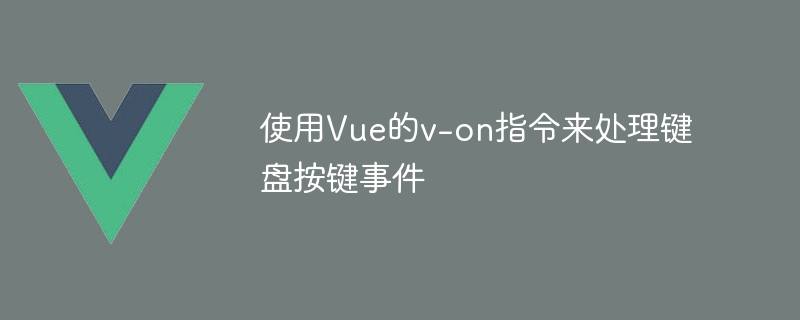Home >Web Front-end >Vue.js >Use Vue's v-on directive to handle keyboard key events
Use Vue's v-on directive to handle keyboard key events
- WBOYWBOYWBOYWBOYWBOYWBOYWBOYWBOYWBOYWBOYWBOYWBOYWBOriginal
- 2023-09-15 10:31:431620browse

Vue.js is a popular JavaScript framework that is widely used in front-end development. Vue provides a wealth of instructions to help developers handle user interaction operations, among which the v-on instruction can be used to bind event handling functions. This article will introduce how to use the v-on instruction to handle keyboard key events and provide specific code examples.
It is very simple to use the v-on directive to handle keyboard key events in Vue. First, in the Vue template, we can use the v-on directive to listen for keyboard key events. The specific usage is as follows:
<template>
<div>
<input v-on:keyup="handleKeyup" />
</div>
</template>In the above code, we use the v-on instruction to monitor the keyup event of the keyboard, and specify the event processing function as handleKeyup.
Next, we need to define the specific implementation of handleKeyup in the Vue instance. The code is as follows:
<script>
export default {
methods: {
handleKeyup(event) {
console.log(event.key);
},
},
};
</script>In the above code, we define the handleKeyup method, which receives an event object as a parameter. We can get the keyboard keys pressed by the user through event.key.
In this way, when the user presses the keyboard in the input box, the handleKeyup method will be triggered, and the keyboard keys pressed by the user will be printed out in the console.
In addition to getting the pressed keyboard key, we can also get more information through the event object, such as the keyCode of the key. For example, we can modify the implementation of the handleKeyup method so that it prints the keyCode of the key in the console. The code is as follows:
<script>
export default {
methods: {
handleKeyup(event) {
console.log(event.keyCode);
},
},
};
</script>When using the v-on instruction to process keyboard key events, we can also further process the key events. For example, we can perform different actions based on the keys the user presses. The code example is as follows:
<script>
export default {
methods: {
handleKeyup(event) {
if (event.key === "Enter") {
// 用户按下了回车键
console.log("用户按下了回车键");
} else if (event.key === "Escape") {
// 用户按下了Esc键
console.log("用户按下了Esc键");
} else {
// 其他按键
console.log("其他按键");
}
},
},
};
</script>In the above code, we can determine which key the user pressed based on the value of event.key, so as to perform the corresponding operation.
To sum up, this article introduces how to use Vue's v-on instruction to handle keyboard key events and provides specific code examples. Through the v-on instruction, we can easily monitor and process keyboard key events to achieve a richer user interaction experience. Hope this article is helpful to you.
The above is the detailed content of Use Vue's v-on directive to handle keyboard key events. For more information, please follow other related articles on the PHP Chinese website!

